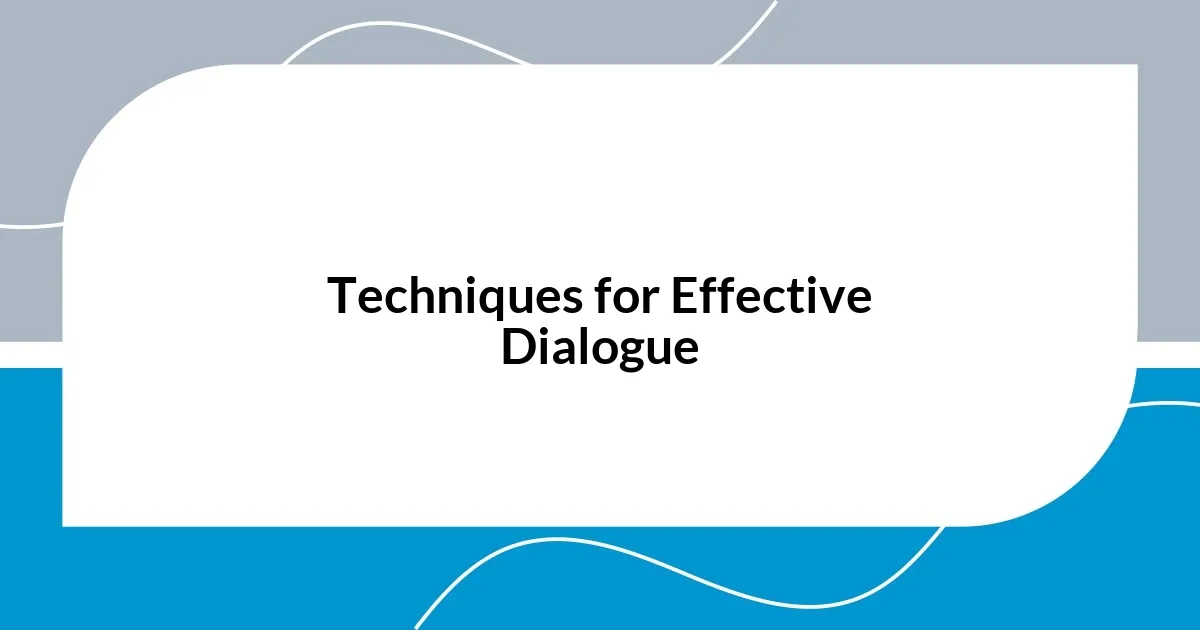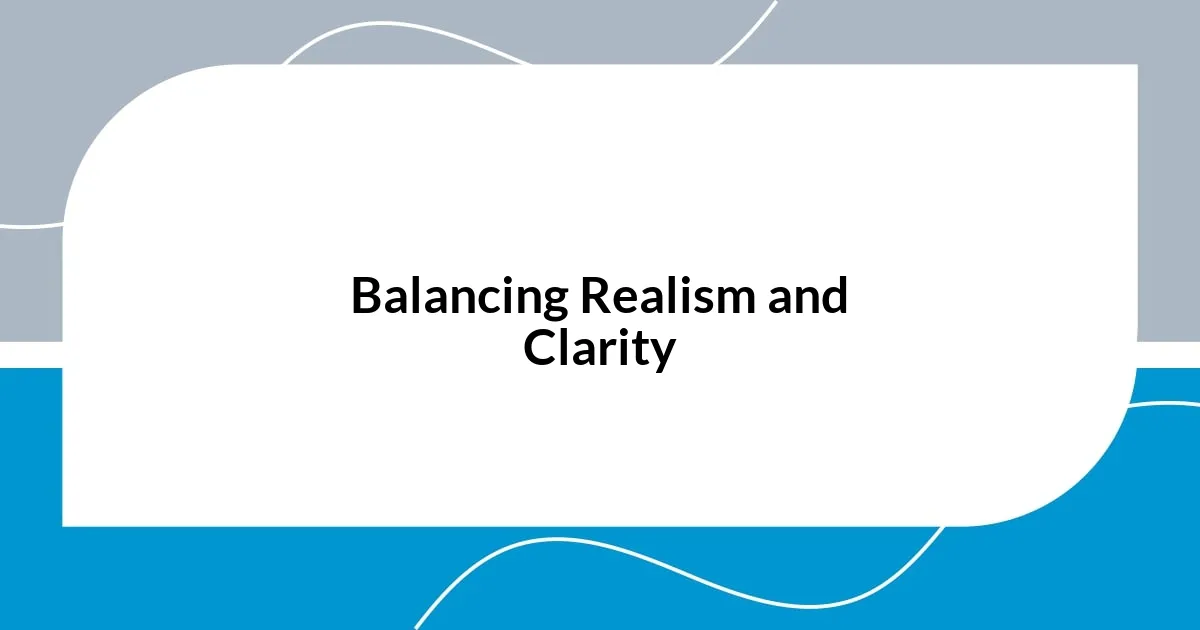Key takeaways:
- Dialogue editing is essential for capturing a character’s voice and emotions, requiring attention to subtext, character voice, and physical actions.
- Effective dialogue should balance realism and clarity, often enhancing understanding through analogies and context clues.
- Strategies for refining dialogue include cutting unnecessary words, showing rather than telling, and focusing on strong verb choices to create impactful exchanges.
- Pacing and emotional resonance in dialogue can be achieved by allowing natural interruptions and leaving moments unspoken to enhance tension and authenticity.

Understanding Dialogue Editing
When I first delved into the world of dialogue editing, I was surprised to find how crucial it is to the overall storytelling process. It’s not just about correcting grammar or removing fillers; it’s about capturing the true voice of the character. Have you ever read a line that just felt off? It might have been a missed opportunity to reflect a character’s unique personality or situation.
One of my early experiences was editing a scene for a novel where the protagonist had just lost someone dear. I realized that the dialogue needed to be laden with grief yet could not sound overly dramatic or cliché. Balancing sincerity with realism became my challenge, and it taught me that sometimes, less is more. How can a few well-placed pauses or interruptions convey deeper emotions? This subtlety can make the dialogue resonate with readers on a personal level.
Editing dialogue also invites you to step into the shoes of your characters. I remember working on a dialogue-heavy screenplay where each character spoke differently, reflecting their backgrounds and desires. It was a revelation to me—how individual quirks and speech patterns helped breathe life into the script. Have you considered how much a character’s speech can reveal about their inner world?

Identifying Key Dialogue Elements
Identifying key elements in dialogue is vital for authenticity. I can’t stress enough how often I search for subtext when editing. For instance, I remember reviewing a dramatic exchange between two friends reconciling after a long fight. The choice of words was critical; I had to ensure they weren’t just saying they were sorry, but that their feelings of hurt and love were layered in their lines.
Another important aspect is character voice. Every time I edit, I pay attention to how each character’s speech reflects their personality. Once, I was editing a piece where one character was a scholar, while another was a street-smart hustler. I made sure their dialogues matched their backgrounds. It really struck me how much personality can shine through when you swap out a few words or adjust sentence structure.
Physical actions can enhance dialogue too. I’ve found that incorporating gestures or expressions can transform the reader’s experience. In one instance, I edited a scene where a character’s nervous habit of fidgeting while speaking added depth. This small detail painted a vivid picture of their anxiety, making their dialogue far more compelling.
| Element | Description |
|---|---|
| Subtext | Underlying meaning or emotion in dialogue |
| Character Voice | Unique speech patterns reflecting personality |
| Physical Actions | Gestures or expressions that enhance dialogue |

Techniques for Effective Dialogue
Effective dialogue often hinges on capturing the rhythm and flow of conversation. I’ve observed that reading lines out loud can reveal awkward phrasing or unnatural pauses that might slip through during silent editing. One memorable session involved tweaking a tense argument between two characters. By allowing their voices to overlap at crucial moments, I was able to create a frantic yet organic exchange that mirrored real-life disputes. The result? A more visceral connection for the reader, as they felt the electricity of the moment.
When I edit dialogue, I also focus on the emotional beats intertwined within the exchange. This is where specificity can breathe life into characters. For instance, in a recent project, one character’s hesitance to answer a question conveyed layers of fear and regret, which transformed a simple response into a poignant moment. To aid in this endeavor, I’ve found these techniques invaluable:
- Voice Matching: Ensure each character’s speech aligns with their background and personality—think vocabulary, cadence, and tone.
- Pacing and Pauses: Use line breaks and punctuation strategically to create tension and allow readers to linger on important moments.
- Emotional Resonance: Infuse characters’ dialogue with underlying emotions, often using subtext to engage readers more deeply in their struggles.
Incorporating these elements can elevate dialogue from mere communication to something meaningful, and empowering.

Balancing Realism and Clarity
Balancing realism and clarity in dialogue is a delicate dance. I often find myself asking, “How can I present a conversation that sounds genuine yet doesn’t lose the reader in confusion?” For example, while editing a scene where characters were discussing a complex topic, I noticed that adding an analogy helped clarify their point. It kept the natural flow of conversation while making their ideas more accessible. Isn’t it amazing how sometimes, a simple tweak can bridge the gap between reality and understanding?
I’ve encountered dialogue that sounded raw and real but bordered on illegible. In one project, characters spoke in local slang, which added authenticity, but it became a hurdle for readers unfamiliar with the terms. To solve this, I carefully wove in context clues or occasional translations that retained the essence of their speech without diluting its flavor. This approach also made me reflect on my own experiences—how often have I needed to clarify something during a heated debate just to make sure my point lands?
Ultimately, I believe it’s about striking a balance between what feels real and what readers can comprehend. When crafting dialogue, I always think of the reader, remembering that clarity shouldn’t come at the cost of losing a character’s voice. There’s something truly satisfying about knowing that readers can immerse themselves in the conversation without feeling lost in the weeds, don’t you think?

Enhancing Character Voice Through Dialogue
Enhancing character voice through dialogue is all about the nuances that set each character apart. I recall a scene where one character, a sharp-witted detective, had dialogue filled with quick repartee that highlighted her intelligence and confidence. By playing with her word choices and sentence structures, I was able to create a rhythm that not only showcased her personality but also added depth to her interactions with others. Isn’t it fascinating how a few well-chosen words can paint a vivid picture of who someone is?
I also make it a point to pay attention to how characters from different backgrounds express themselves. In one instance, I edited a conversation between a tech-savvy teenager and her more traditional grandmother. Their contrasting styles naturally emerged when I highlighted their unique slang and expressions. It felt rewarding to weave in those distinctions, showing readers the generational gap without explicitly stating it. Don’t you think those little details can make characters feel more authentic and relatable?
Moreover, I often reflect on how my editing choices can influence the overall tone of the dialogue. For instance, in a story where a character grapples with grief, I chose to let her dialogue simmer with hesitance and fragmented thoughts. It created an emotional weight that resonated with readers, allowing them to connect with her pain on a deeper level. I’ve learned that taking time to refine character voice is not just an editing task; it’s an opportunity to bring my characters to life in a way that lingers in the minds of readers long after they close the book.

Strategies for Cutting Unnecessary Words
Cutting unnecessary words can sometimes feel daunting, but I’ve found a few effective strategies that help streamline dialogue. One method I often use is to focus on the essentials of what the characters really want to convey. I remember editing a heated exchange where one character would say, “I really think we should go now,” and realized that “We should go now” was much more impactful. Aren’t we all guilty of adding fluff to our speech?
Another tactic I embrace is the art of showing rather than telling. Instead of characters redundantly explaining their emotions, I lean into gestures, expressions, or even breathed-out words that convey feeling. I once worked on a scene where a character was frustrated and kept elaborating on it. By incorporating a simple clenched fist and a sigh instead of lengthy explanations, the tension intensified, making readers feel the weight of the moment. How often do we communicate so much without even saying a word?
Lastly, when trimming dialogue, I find that removing adverbs can lead to stronger verb choices, stripping down to the core action. For instance, instead of writing, “She spoke angrily,” I’d revise it to “She snapped,” which conveys the emotion more forcefully. This approach not only sharpens the dialogue but also allows me to keep the reader engaged—because who doesn’t appreciate a punchy exchange? Being aware of word choice and intent can elevate a scene, turning good dialogue into something truly memorable.

Finalizing and Polishing Edited Dialogue
Finalizing dialogue can feel like putting the finishing touches on a painting—every little detail matters. I remember a time when I was polishing a conversation between two best friends who were having a serious discussion. Initially, the dialogue felt heavy, but as I refined their exchanges, I focused on how they would naturally interrupt each other, bringing a sense of authenticity. It transformed the scene into something that felt alive and real. Have you ever noticed how our closest friends have a rhythm in their conversations that flows effortlessly?
To really make that dialogue shine, I also pay close attention to pacing. For instance, in a recent project, I had a tense confrontation where I intentionally broke up lengthy speeches into sharp, crisp lines. This not only enhanced the urgency of the moment but also mirrored how real-life conversations can shift rapidly, keeping readers on their toes. It’s incredible how slight adjustments in pacing can create a dramatic impact, don’t you think?
Another crucial aspect I consider is the emotional resonance of the lines. In a scene filled with unspoken tension, I chose to leave some things unsaid, allowing the silence between the characters to speak volumes. At one point, two characters were on the verge of a confession, and I realized that their hesitation and the weight of what remained unspoken added a depth that mere words couldn’t capture. It reminded me that sometimes, less truly is more when it comes to dialogue. How often do we find ourselves caught in moments where the silence actually speaks louder than the words?